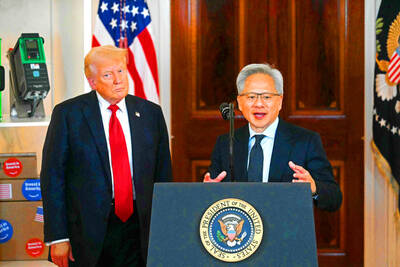The level of joblessness last month climbed for the fourth straight month to 4.4 percent, the Directorate-General of Budget, Accounting and Statistics (DGBAS) said yesterday, adding that the nation’s unemployment rate might improve this month based on historical experience.
The rate of unemployment — an indicator of slowing economic performance — last month marked its highest level since August last year and was up from 4.31 percent in July, the agency said in its monthly report.
The seasonally adjusted unemployment rate, a more reliable indicator of the long-term trend, was up 0.04 percentage points from the previous month to 4.29 percent last month, the report said.
“The seasonal effect continued to be the main factor that pushed up the jobless rate last month,” DGBAS deputy director Chen Min (陳憫) told a press conference.
A majority of the college graduates entering the labor market have done so in the past few months, but some have not received job offers yet, which is why unemployment has continued to climb, Chen said.
The slowing economic sentiment was another factor that helped drag down the labor market as a conservative attitude among employers made them less likely to recruit personnel, including first-time jobseekers, Chen added.
The latest data showed that 502,000 people were unemployed last month, an increase of 12,000 from the previous month, with the number of first-time jobseekers failing to find employment rising by 8,000.
The increase was also reflected in growing youth unemployment, with joblessness among 15-to-24-year-olds rising 0.65 percentage points from July to 13.61 percent last month, its highest level this year, the report showed.
However, Chen said the historical trend in the rate of unemployment showed that the figure usually rose to its highest annual level in August and further improved in the following months.
This would indicate that this month’s jobless rate remains an important indicator to evaluate the current national labor market situation, Chen added.
Tony Phoo (符銘財), a Taipei-based economist at Standard Chartered Bank, said that he expected the unemployment rate to show an improvement from this month, as exports return to a modest level of growth in the fourth quarter.
“Regardless of the impact of the seasonal effect, the employment situation has not improved over the past three months,” Phoo said in a telephone interview.
Phoo expected the unemployment rate could drop to between 4.2 percent and 4.3 percent by the end of this year, with job openings offered by the service sector and the financial industry leading the trend.
The DGBAS also released the latest salary data yesterday, which showed that national monthly salaries averaged NT$37,435 (US$1,270) in July, up 1.63 percent from a year ago.
However, when bonuses and other forms of compensation are included, the average monthly remuneration package showed a 0.44 percent markdown from a year earlier and stood at NT$42,535 in July, the data showed.

Taiwan Semiconductor Manufacturing Co (TSMC, 台積電) last week recorded an increase in the number of shareholders to the highest in almost eight months, despite its share price falling 3.38 percent from the previous week, Taiwan Stock Exchange data released on Saturday showed. As of Friday, TSMC had 1.88 million shareholders, the most since the week of April 25 and an increase of 31,870 from the previous week, the data showed. The number of shareholders jumped despite a drop of NT$50 (US$1.59), or 3.38 percent, in TSMC’s share price from a week earlier to NT$1,430, as investors took profits from their earlier gains

AI TALENT: No financial details were released about the deal, in which top Groq executives, including its CEO, would join Nvidia to help advance the technology Nvidia Corp has agreed to a licensing deal with artificial intelligence (AI) start-up Groq, furthering its investments in companies connected to the AI boom and gaining the right to add a new type of technology to its products. The world’s largest publicly traded company has paid for the right to use Groq’s technology and is to integrate its chip design into future products. Some of the start-up’s executives are leaving to join Nvidia to help with that effort, the companies said. Groq would continue as an independent company with a new chief executive, it said on Wednesday in a post on its Web

CHINA RIVAL: The chips are positioned to compete with Nvidia’s Hopper and Blackwell products and would enable clusters connecting more than 100,000 chips Moore Threads Technology Co (摩爾線程) introduced a new generation of chips aimed at reducing artificial intelligence (AI) developers’ dependence on Nvidia Corp’s hardware, just weeks after pulling off one of the most successful Chinese initial public offerings (IPOs) in years. “These products will significantly enhance world-class computing speed and capabilities that all developers aspire to,” Moore Threads CEO Zhang Jianzhong (張建中), a former Nvidia executive, said on Saturday at a company event in Beijing. “We hope they can meet the needs of more developers in China so that you no longer need to wait for advanced foreign products.” Chinese chipmakers are in

POLICY REVERSAL: The decision to allow sales of Nvidia’s H200 chips to China came after years of tightening controls and has drawn objections among some Republicans US House Republicans are calling for arms-sale-style congressional oversight of artificial intelligence (AI) chip exports as US President Donald Trump’s administration moves to approve licenses for Nvidia Corp to ship its H200 processor to China. US Representative Brian Mast, the Republican chairman of the US House Committee on Foreign Affairs, which oversees export controls, on Friday introduced a bill dubbed the AI Overwatch Act that would require the US Congress to be notified of AI chips sales to adversaries. Any processors equal to or higher in capabilities than Nvidia’s H20 would be subject to oversight, the draft bill says. Lawmakers would have